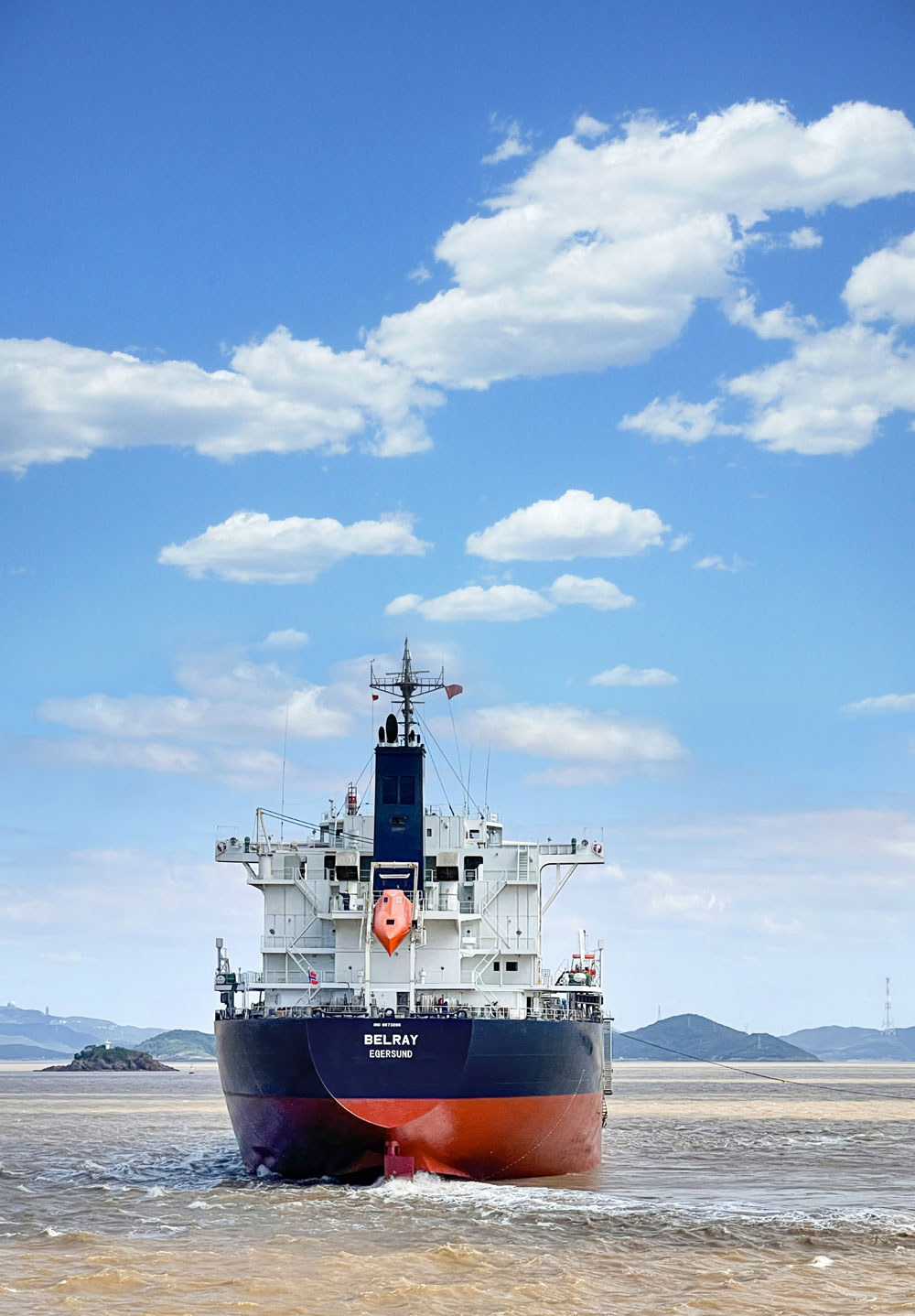

History
Shipping is a volatile business which both reflects and connects the world. The Company was founded more than a century ago, in 1918, and has experienced the global impact of roaring economic growth, numerous financial crises, terrorism and two wars.
The Beginning
The First World War had entered its final months when Christen Smith, a Norwegian entrepreneur and master mariner, invited investors to become shareholders in Skibsaktieselskabet Christen Smiths Rederi. Railways were being expanded on a massive scale. In the so-called new world (Africa, Asia and South America) railways were being constructed to bring out resources from remote areas and to facilitate development in these regions. Locomotives and railway cars were manufactured in Europe, primarily in Great Britain. This is where Christen Smith, the company founder, saw his opportunity: no vessels were able to transport the heavy locomotives from Europe to the new railways, the traditional solution was to dismantle the locomotives, ship them in parts and then reassemble them at the destination. Christen Smith had found his niche. He designed ships with heavy duty cranes and derricks on deck, able to handle even the largest locomotives in one haul.
An Immediate Success
The concept became an immediate success. For more than a decade Christen Smith dominated the heavy lift trade. The chimneys decorated with the CS initial and the anchor (which still is Belships’ logo), became a familiar sight in ports all over the world. The names of his vessels all had the prefix BEL (Smith’s first two vessels were BELFRI and BELGOT), and in shipping circles heavy lifters were soon commonly referred to as “Belships”.
1930s
During the economic downturns in the 1930s the Company was restructured and emerged in 1935 under its new name: Belships Company Limited Skibs-A/S. Two years later, the Company made another share issue and became listed on the Oslo Stock Exchange.
Through the 1937 listing and restructuring, three brothers became key shareholders: Axel, Frithjof and Jørgen Lorentzen. They soon assumed control of the Company. The brothers, their children and grandchildren would remain at the Belships helm for the next eighty years.
World War II
During the Second World War the Belships fleet was in greater demand than ever before. Heavy military equipment needed to be transported efficiently over great distances. For the duration of the war, the fleet was under allied control. The post-war decade became Belships’ heydays as a heavy lift shipping company. The world was being rebuilt after a devastating war. Locomotives and heavy machinery for industry and power plants were needed everywhere. In addition, the four year-long war on the Korean peninsula created significant transportation needs for the American forces.
Post War Opportunities
Later, conventional liner vessels increasingly were equipped with heavy gear, and the demand for the “belships” receded during the 1960s. Reconstruction after the war was completed, and with decolonisation the emerging countries increasingly set about manufacturing their own railway equipment and other heavy goods. Belships sold its last heavy lift vessel in 1972.
However, the Company entered changing times in good shape. The heavy lift trade had been highly profitable for years and the Company had the financial resources to explore new opportunities. After having explored tankers, dry bulk, refrigeration and car transportation, Belships chose to focus on dry bulk and large tanker vessels.
1970, 80 and 90s
Then the 1970s shipping crisis hit. Dramatic changes in world trade, with particularly adverse effect on oil trade, coincided with an excess capacity of tankers. For years, the global shipping industry was dried up. Belships had contracted several new ships just before the market imploded. Almost brand new vessels were laid up, sold at losses or scrapped. Belships crude tanker adventure came to an abrupt halt.
Belship’s management recognised that the times called for a focusing of the Company’s activities, and chose dry bulk and the vessel category handysize; medium-sized vessels of 35-40 000 dwt. In the mid-1980s, Belships made one of its boldest moves ever. Dry cargo freight rates were low and prospects highly uncertain. Nevertheless, Belships acquired a significant number of handysize vessels, and stretched the Company’s financial capabilities to the limit. Then the market turned. Towards the end of the 1980s, dry bulk rates were at exceptionally high levels and Belships risk taking was well rewarded.
The financial crisis in Asia hit at the end of the 1990s. Dry bulk rates fell to very low levels and Belships needed to rethink its strategy. Belships turned to larger dry bulk vessels as well as product tankers. Also, Belships acquired the small Scottish gas tanker company Gibson Gas.
When the new millennium dawns, Belships’ activities are broad. Operations include three tonnage categories of dry bulk, product tankers and small gas tank shipping. Optimism prevails: the Asia crisis is over, and freight rates are climbing. All looks good. Until four hijacked airliners change the world.
9/11, Financial Crisis and China
When world trade finally recovers from the financial aftermath of 9/11, dry bulk is leading the way in the shipping markets. China’s economic growth creates a strong demand for raw materials, and in the coming years the Middle Kingdom is the main driver in the dry bulk market. Belships decides to once again put all the eggs in the dry bulk basket, expands the fleet and acquires 50% of Elkem Chartering. Once again Belships has hit the bull’s eye. Dry bulk freight rates reach all time high levels both in 2003 and 2004. Belships says goodbye to Gibson Gas and orders new ships. For the first time in quite a few years, Belships will have a significant and fully owned dry bulk fleet. And the Company turns to the new vessel category Supramax; dry cargo ships between 40 and 60 000 dwt. Times are extremely good.
Once again events in the United States changed the game. The 2007-2008 financial crisis affected world trade on an unprecedented scale. Freight rates plummeted again and financing of newbuildings became extremely difficult. When the crisis hit, Belships was in the process of acquiring six new vessels. Financing of the entire programme proved impossible, and Belships had to reduce the fleet expansion programme at a significant loss. In the annual report, the Company’s Board of Directors described 2008 as “a year of extremes”.
As the financial turmoil subsided, it was once again China that brought dry bulk freight rates back up. Belships made a profitable divestment of its stake in Elkem Chartering and exited all other segments except Supramax/Ultramax dry cargo. The Company’s strategy going forward is straight and narrow: A pure supplier of Supramax/Ultramax dry bulk tonnage. At the beginning of 2018, Belships operated six vessels in this category on 1-3 year contracts.
Merger with Lighthouse Group and Further Growth
When Belships merged with the Lighthouse Group in December 2018, the fleet was more than doubled and a forceful and pure Supramax/Ultramax dry bulk company was formed.
2018 was not only the year of a centennial anniversary for Belships ASA, but also the end of an era and the beginning of a new. Through a series of sale and purchase transactions and execution of long-term charter contracts with Japanese counterparts the Belships fleet grew rapidly over the next years. By the end of 2024 the fleet comprised 30 vessels on the water and a further 12 newbuildings for delivery during 2025 through 2028. Belships thus controlled the youngest Ultramax fleet in the world with an average age below 4 years (including newbuildings), as well as being one of the world's largest owners of Ultramax tonnage.
In 2020 Norwegian Bulk Carriers was founded, and Norwegian Bulk Carriers AS now operates 60-70 vessels on long and short-term period, single voyages and commercial management.
New Ownership
After having been listed at the Oslo Stock Exchange since 1937, on December 19, 2024, Belships announced an agreement with a company established by Entrust Global, a global asset manager with multiple investments within shipping and offshore, to make a voluntary cash offer to all shareholders in Belships. The offer was unanimously recommended by the Belships' board, and was completed during the first quarter of 2025. Following the delisting from the Oslo Stock Exchange, Belships is now 74.99% indirectly owned by the Blue Ocean Funds, a maritime investment platform managed by EnTrust Global. The Blue Ocean team has established itself as one of the world's leading maritime investors, with debt and equity investments in dry bulk, container, tanker, offshore, gas, cruise, and intermodal sectors.
The remaining 25.01% is owned by the F. Laeisz Group, a diversified family-owned group of companies with a 200-year history, which has its main interests in shipping, trade and insurance.
A Century At Sea

Author: Per Arne Totland